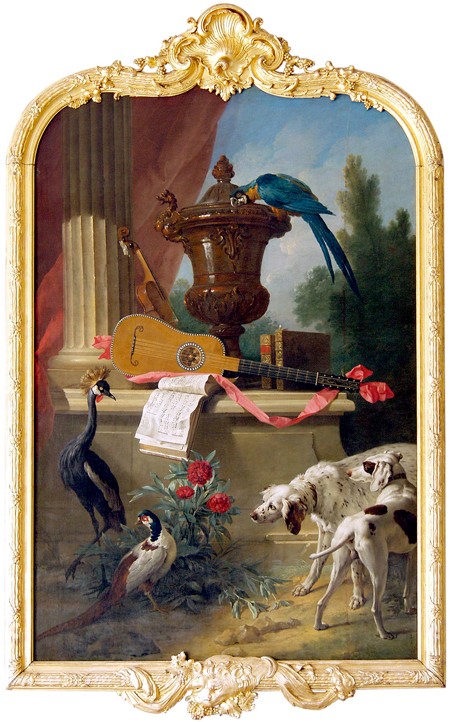The term rococo was allegedly born around 1797 in that crucible of artistic and political modernism, the atelier of Jacques-Louis David. His most radical students responded to their master’s Intervention of the Sabine Women (1799) with the accusation “Vanloo, Pompadour, Rococo!” in reference to the former king’s mistress, Madame de Pompadour, and one of her favorite painters, Carle Vanloo. The word rococo appears to have been studio argot that combined the first syllables of two less judgmental formal descriptors common in eighteenth- century France, rocaille (rock work) and coquillage (shell work). Both had been used since the 1720s to denote objects and designs that we now think of as rococo—by artists such as Juste-Aurèle Meissonnier, Jacques de Lajoüe, or Jules-Marie Oppenord—within the broader category of goût nouveau or style moderne, which distinguished them from classicism under Louis XIV. Design defined by its newness in the 1720s and 1730s suffered critical backlash in the late 1740s, however, and by the end of the century was alternately villainized and praised for its stylistic as well as accrued political and ideological dimensions. A category of objects that never had its own master, school, or theoretical voice was thus transformed into a symbol of things beyond itself. The research conducted over the course of my fellowship attempts to redress the problematic category of rococo painting as inherited by art historians from David’s students by pursuing two claims: that the status of the various arts was in flux at this time and that it is productive to return to a period view of the fine and decorative arts as deeply intertwined. While on the one hand questioning the historiographic fortune of rococo painting, on the other I aim to propose a new methodology for its interpretation that expands the scope of objects considered in sympathy with their original purposes.
The first claim asserts that a strong logocentric bias for interpreting eighteenth-century French art was established in its own time by the Académie royale de peinture et de sculpture as it wrestled painting from the mechanical into the liberal arts. I argue that this move from studio to Salon (or, more broadly, spaces of production to spaces of reception) was crucial not only in obscuring the realities of artistic practice but also in producing a rich body of art theory and criticism that modern art historians have found difficult to escape. This tendency of the historical record itself was amplified by the coincidence of a pivotal scholarly reappraisal of eighteenth-century French visual culture at the moment of art history’s linguistic turn in the 1980s and 1990s.
The second claim stems from the first and ultimately structures this study. I contend that the categorization of painting as an autonomous object of aesthetic contemplation devoted to historical narrative encouraged by contemporary academicians and Salon critics placed inappropriate demands on many works produced in this period. Rather than distinguish and elevate painting from a range of material culture because of its medium or depicted subject, I argue for a realignment between fine and decorative arts by thinking through a mode of production that draws forth an overlap between them, namely, the “cut-and-paste” maneuver of my project’s title. The term découpage encapsulates this operation literally, but I employ “cut and paste” to describe a modality in which the visual world is comprehensible and employable as an array of discrete motifs that, once selected, could be used and reused in the manner of a pattern book, a collection of “mobile images.” This was a system inculcated at the earliest stage of learning to draw in eighteenth-century France, where copying two-dimensional motifs was the foundation of art education no matter the medium of a student’s future specialty, from oil on canvas to porcelain, textiles, wood, or metalworking. For painters this practice was reinforced on the mechanical side of their profession by phenomena typically left out of art-historical accounts, including studio production, designs for the print market, and arabesque decoration. Academicians did not operate unfailingly through a cut-and-paste approach but had recourse to this modality, particularly when pursuing the period’s most remunerative commissions that touched on the realm of decoration: tapestry designs, boiseries, overdoors, and overmantels. Although prioritizing a motif’s mobility was well suited to such works, it was far less conducive to depicting complex narrative subjects and left a large portion of artistic production open to derision at the level of art theory and, ultimately, art history. Later attempts to refit these works as autonomous objects—either conceptually through text or literally through cutting down or building out canvases to fit rectilinear frames—has further reinforced the perception that some of the key painters of eighteenth-century France were in fact interlopers in the world of fine art.
